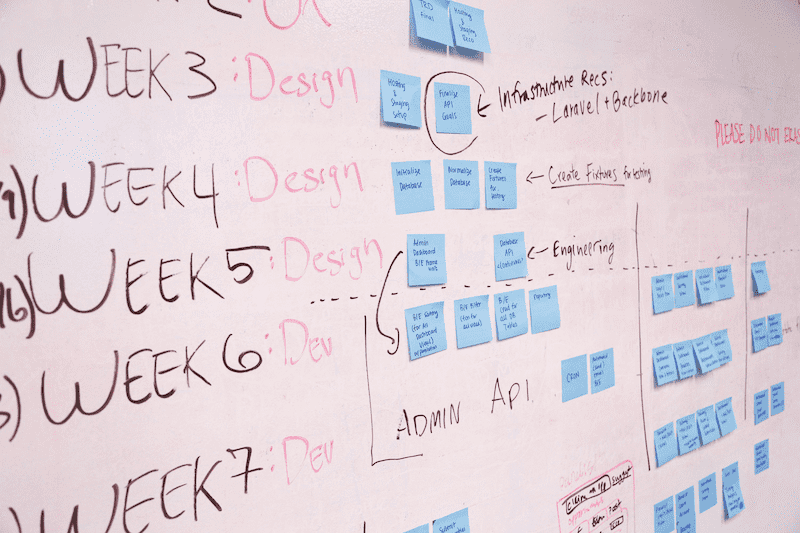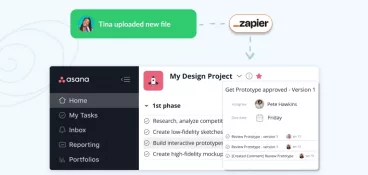Got an idea for a project but now sure what to include for stakeholder approval? Never fear, we’re here with the essentials.
We’ve all worked on a project where the goalposts seem to keep moving during the project approval process. Maybe the stakeholder has decided they want to go in another direction, maybe they want to move the deadline, or maybe they just plainly aren’t on board with your idea.
That’s where a well thought-out project approval form comes in handy during project planning. Did you know that almost 90% of people say they’d feel happier at work if their team had a more efficient review and approval process?
A solid project approval form facilitates a space to lay your cards out on the table and be completely transparent with your stakeholders. This ensures there are no crossed wires and misunderstandings between parties, so clients can formally approve the project.
Take a look at our essentials guide for building your own project approval form. We’ll cover the best tools to use during the project approval process, and everything you should include.
But first …
What is a project approval form?
A project approval form template is a form that helps teams and project managers pull together an intricate list of the proposed project details. It helps convey the project details to clients for approval.
They can be generated through project management software like monday and Smartsheet, or they can be created manually by the project manager.
The project approval form helps to provide clients with the framework to summarize the project and begin the project approval process. This includes action to completion, exact time frames, budget, roles, and resource requirements.
With a detailed project approval form, the client approval process is made easier and more efficient. Stakeholders can divulge in and evaluate costs versus resources and project benefits to determine project approval and move forward with the proposed project.
While project approval forms will vary from team to team and project to project, here are the five project approval form template essentials that we’ll be exploring in this article:
- Project summary
- Project roles
- Budget
- Resources
- Timelines
Let’s take a closer look.
See all your project’s feedback in one place
Bring files, versions, feedback, and approvals together with Filestage.
1. Project summary
This one goes without saying, really, but the main (and first) component of a project approval form template should be the proposed project outline.
The project outline helps everyone to understand exactly what the project will include content-wise, aligning with the organization’s specific brand, wants and needs.
As well as being essential for stakeholders for formal approval, a project approval form is a document that teams and the project manager will refer back to throughout the duration of the project. So, it’s best to keep it as detailed as possible.
Let’s say it’s a graphic design project for a product advert. With the project approval form template, it gives teams space to show everyone exactly what the goals and strategy of your project are for project approval.
This could include:
- An overview of the brief
- The project objectives and project benefits
- The project’s desired audience and how it will reach them (social media, print, TV)
- Any techniques or programmes that the team will be using
- A brief mock up of what the final product could look like (visuals are always useful)
2. Project roles and responsibilities
It’s essential for both teams and clients to know exactly who is doing what in their projects. These guidelines are essential to keeping a streamlined workflow.
It’s important to remember that roles are not the same as team members. A single team member can take on multiple roles, so it’s important to specify which roles belong to which team members.
Why specify roles and responsibilities? Well, it’s a useful way of letting clients and other team members know who is working on each element of the project.
It helps teams identify where work could potentially overlap, creating a more harmonious workflow. And it also acts as a contact list so teams know who to contact with any problems, questions, or comments.

3. Budget
Conversations about money and budgeting are always … interesting.
Giving your project approval form template a place to break down your budget can save a lot of awkward discussions and potential financial mix-ups, which can be detrimental to the project.
Budgeting before your project is approved is a sure-fire way to check that all costs are covered. It’s a good way to pitch your budget to stakeholders to ensure you’ll get the budget you need.
A detailed budget helps stakeholders understand how costs will contribute to the production of the project and how these costs will adhere to the project’s goals.
As with most projects and their budgeting, you’re sure to run into one or two problems which could potentially result in extra costs. Having your project budget as a baseline can help to control spending and mitigate extra costs in case they arise.
Top tip: It’s always a good idea to include a contingency fund. This shouldn’t be used as a target, but as a safety blanket in case of emergencies.
4. Resources
This is basically the ‘how’ of your project approval form. How will you source materials, how will you be using them, and what programmes, software, or platforms will you be using?
It’s important to outline your resources for the project for both the team and stakeholders. It ensures that everyone is aware of how the project is being executed and which deliverables are included.
Outlining your desired resources is important to the budget, too. A lot of online tools and software come at a cost with a one-time purchase or subscription service, which can differ in price depending on the number of users and premium features.
Ultimately, stakeholders want their projects to be as successful as possible. So being completely transparent and listing them in your project approval form template is essential for reassuring them that the best-of-the-best resources are being used.
Not forgetting it’s a good way to get your favorite programmes, software, and freelancers approved. Win, win!
5. Timelines
We’ve all been there: a deadline is missed, a team member is falling behind, clients are chasing project managers – and you’re losing out on valuable project time. The ball has well and truly dropped.
This is why a timeline is important to include in a project approval form.
Timelines act as an efficient way to improve communication. Communication between project managers, teams, and stakeholders is crucial to project approval forms as it gives everyone a reference on where the project is in the process. This offers an important point of reference for communication.
A project timeline has a starring role in any project. It allows project managers and team members to prioritize their tasks, improving overall time management and streamlining the workflow.
Having a physical timeline as a point of reference is a great motivator. It can be super-efficient for team members and project managers to track where they are in the project, what’s been done, and what’s coming up.
Top tip: When creating your project timeline in your project approval form, set deadlines for your feedback rounds too. Then, if you use a project approval tool like Filestage, you’ll be able to set these deadlines as due dates to make sure feedback and approval arrives on time.

Final thoughts
Whether you’re a large firm, smaller company, or simply a solo freelancer, creating a clear and concise approval request form template will help you in a wide range of projects.There are plenty of tools out there to help you create a free project approval form template. And by including topics like project summary, key roles, and budget, you’ll give yourself a solid foundation that you can refer back to as the project progresses.






